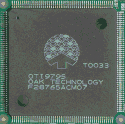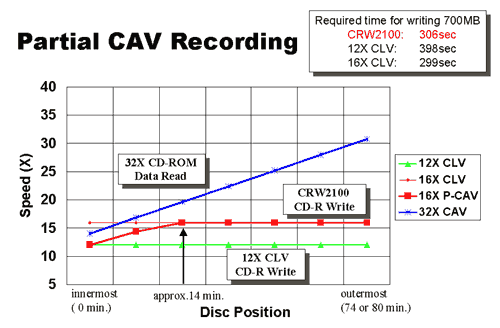Yamaha CRW2100E CD-RW
1. Introduction
Review Pages
Introduction :
 Yamaha
is well known to CDR users from its long history. If we go back in the past
we will find that it made a lot of breakthrough moves by leading the recording
race. Yamaha drives were the fastest drives from 1990 (100x series) to 1998
(4416x series). However at that point Yamaha stayed back in the developing of
CDR-W drives. The competition (Plextor) started using Sanyo laser pick-ups (and
chips) so the result was that at the same time that Yamaha was introducing an
8x-writing drive (8424x series) the competition had already shipped a 12x solution
(Plextor PX-W124TS). We witnessed the exact same situation when Yamaha shipped
it's 8x re-writing drive (8824x series), the competition again was faster and
was already introducing 10x re-writing solutions.
Yamaha
is well known to CDR users from its long history. If we go back in the past
we will find that it made a lot of breakthrough moves by leading the recording
race. Yamaha drives were the fastest drives from 1990 (100x series) to 1998
(4416x series). However at that point Yamaha stayed back in the developing of
CDR-W drives. The competition (Plextor) started using Sanyo laser pick-ups (and
chips) so the result was that at the same time that Yamaha was introducing an
8x-writing drive (8424x series) the competition had already shipped a 12x solution
(Plextor PX-W124TS). We witnessed the exact same situation when Yamaha shipped
it's 8x re-writing drive (8824x series), the competition again was faster and
was already introducing 10x re-writing solutions.
 It
became quite obvious to the power users that if Yamaha didn't present something
unique and fast, the future would be very dark. The time had come for a change
in the company's main philosophy, which was: "..All parts of the CDR-W
drive MUST come from Yamaha and not relying to other manufactures.."
It
became quite obvious to the power users that if Yamaha didn't present something
unique and fast, the future would be very dark. The time had come for a change
in the company's main philosophy, which was: "..All parts of the CDR-W
drive MUST come from Yamaha and not relying to other manufactures.."
 The
door opened for possible co-operation with other manufacturers, in order to
regain the lost ground. Yamaha had two possible manufactures that could co-operate:
OAK Technologies and Cirrus Logic. Yamaha chose as an ally the OAK
Technologies , since the Cirrus Logic chipset was/is used by Sony and Philips.
The CRW2100E uses 2 chipsets (one from OAK and one from Yamaha) and the pickup
is made from Yamaha. The CRW2100x series drives according to Yamaha includes
various enchaments over the previous models:
The
door opened for possible co-operation with other manufacturers, in order to
regain the lost ground. Yamaha had two possible manufactures that could co-operate:
OAK Technologies and Cirrus Logic. Yamaha chose as an ally the OAK
Technologies , since the Cirrus Logic chipset was/is used by Sony and Philips.
The CRW2100E uses 2 chipsets (one from OAK and one from Yamaha) and the pickup
is made from Yamaha. The CRW2100x series drives according to Yamaha includes
various enchaments over the previous models:
 -
16x writing/10x re-writing/40x reading:
-
16x writing/10x re-writing/40x reading:
Yamaha CRW2100E is the first CDR-W drive that supports 16x writing. However
16x writing uses partial CAV writing technology. What is partial CAV technology?
"...CAV (Constant Angular Velocity) method uses a constant disc rotation speed at any portion of the disc whereas the data transfer rate will vary. Because CAV method has an advantage to largely increase the data transfer rate with a minimum load to the drive's mechanism (compared to CLV's rotation speed adjustment), many of current CD-ROM drives use CAV method. CD formats define the constant linear density of written data (data should be written onto the disc track in the constant pitch) so that amount of recorded data per disc rotation will increase as the writing point moves from the inner to the outer. In other words, in CAV writing the outer portion has an increased data transfer rate.
The CRW2100 series uses CAV method in the inner portions as well as CLV method in the outer portions (Partial CAV) in order to enable up to 16X-speed writing while pursuing high-quality. The drive will control the disc rotation speed to start writing at 12X speed in the inner portions, gradually accelerating up to 16X speed and maintaining 16X speed in the outer portions..."

In other words the Yamaha will start writing CDs at 12x until the 14th min and then will continue writing at 16x untill the end of the disc. Also as the above graph states that it won't be as fast as 16x CLV recording. Why Yamaha has chosen the partial CAV as the default writing mode instead of 16x CLV? The new Yamaha supports 10x re-writing. Or not? Actually Yamaha supports 8x re-writing (CLV) when used for RW writing and 4x-10x re-writing (CAV) when used for packet writing tasks. This we could say it's a marketing trick since the drive re-writes at 10x only under specific conditions. Finally the CRW2100x series supports up to 40x reading. That means it will be the fastest drive around and also support up to 40x DAE!!!
- 8MB of Buffer:
The Yamaha drive also doesn't include any kind of anti-coaster technology
in order to avoid buffer underruns. The only manufacturers, which have developed
such technologies, are Ricoh and Sanyo. In order to avoid those kinds of problems
Yamaha included an 8MB Buffer in the drive. That is supposed to solve the buffer
underrun problems but the software will play a major role here. You will read
later how the drive performs in this area.
- Pure Phase Laser System:
Yamaha's Pure Phase Laser System eliminates unwanted reflections and glare
produced when recording a CD, and stabilizes the laser power, resulting in more
accurate recording and reduction of jitter (deviation from correct signals)
by 25%, ensuring high recording reliability even at high speeds. Both your audio
and data recordings will be of a higher quality, and there is less risk of non-compatibility
in CD ROM playback."
 -
Optimum Write Speed Control
-
Optimum Write Speed Control
Even though the CRW2100 has very fast recording capability, it still has
to check if the media is capable of performing at such speeds. Before writing
to CD-R, the CRW2100 checks the media's capability and automatically selects
the optimum writing speed, to improve reliability. That means if you try writing
at 16x with 8x certified media, Yamaha CRW2100E will automatically lower the
write speed to 12x in order to protect the quality of the produced CD. Most
current 12x certified media will work fine at 16x.
Review Pages













